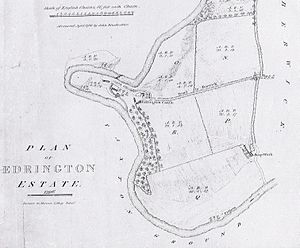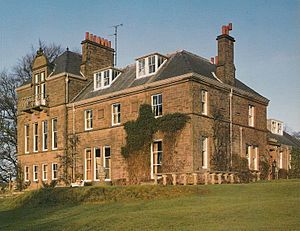Edrington facts for kids
Edrington is an old estate in Scotland, located about 5 kilometers (3 miles) west of Berwick-upon-Tweed. It's in the lower part of the Mordington area in Berwickshire, Scottish Borders. For many centuries, a castle stood on a steep hill above a mill, both sharing the name Edrington, next to the Whiteadder Water river. Even today, the castle ruins are marked on maps and mentioned in local news. The main farm on the estate is called Edrington Mains.
Contents
Edrington: A Historic Scottish Estate
Some historians believe the name Edrington comes from its closeness to the Whitadder river. It's known as one of the oldest strongholds in the Scottish Borders. The ancient castle was built on a high bank, making it a very strong and important place.
Early records show that the lands of Edrington were given to a religious group called Coldingham Priory around the year 1097 by King Edgar. This was to support the Priory. Although the lands were once claimed by a powerful English region (Durham), they soon became part of the Scottish Crown.
The Early Days and Disputed Lands
In 1304, records mention "the King's lands of Edringtone" and "the King's mill" there. At this time, the "King" was Edward I of England. Edrington was often a disputed area between Scotland and England, even though it has always been in Scotland.
For a long time, the owners of Edrington were the Lauder family, known as the Lauders of The Bass. This family was very important in Scottish history. They fought alongside famous Scottish heroes like Sir William Wallace and Robert The Bruce. Robert The Bruce even appointed one of them, Sir Robert de Laweder, as a chief judge in Scotland before 1316.
In 1328, Robert The Bruce gave back lands to an English noble, and Sir Robert de Laweder was a witness to this important document. He also went on diplomatic trips to England in 1329. By 1330, he owned the fishing rights at Edrington and was in charge of Berwick Castle.
Sir Robert Lauder and his son were both at the battle of Halidon Hill in 1333, which was only about 2 kilometers (1.2 miles) from Edrington Castle. It's said that the older Sir Robert was too old to fight on foot, so he stayed on his horse.
During the wars with England, the Lauders often lost Edrington and other estates to the English King. But they always got them back when Scotland regained control. The Edrington Mill was rented out to another family until 1376. After that, the Lauders hired millers directly.
Important Owners: The Lauders in the 15th Century
In 1423, a knight named "Robertus de Lawedre de Edryngtoune" was involved in getting King James I of Scotland released from being held captive. He was also confirmed as the owner of Edrington and other family estates in 1425. He was also a judge and even the Governor of Edinburgh Castle between 1425 and 1433. His name is still on a list of governors at Edinburgh Castle today.
Later, around 1450, the King again confirmed that Robert Lauder of Bass owned Edrington. In 1462, Berwick-upon-Tweed Castle was put under the care of Robert Lauder of Edrington. He was paid to make repairs to the castle in 1464.
In 1471, the King confirmed that Robert Lauder junior would inherit Edrington, including the castle, mill, and fishing rights. His father, Robert Lauder senior, agreed to this. In 1478, Robert Lauder of Edrington was again put in charge of Berwick Castle for five years. He was paid a good amount for this important job.
In 1489, King James IV confirmed various lands to "his squire, Robert Lauder of Edrington." This Robert Lauder married Isobel Hay, who was a descendant of Robert The Bruce.
The 16th Century and the Castle's Challenges
Throughout the 1500s, the Lauder family continued to own Edrington. Records from 1509 and 1519 confirm their ownership of "the lands of Edringtoun with tower, and mill."
Around 1540, there was a dispute when someone tried to stop people from using Robert Lauder's mill at Edrington.
In 1542, King James V ordered that Edrington Castle be blown up because the English had taken it over. However, this order was never carried out.
Robert Lauder of The Bass (who died in 1576) was a supporter of Mary, Queen of Scots. He even loaned her money. Because he supported her, some of his goods and lands, including Edrington, were temporarily taken away, but he later got them back.
Later in the 16th century, George Lauder, a younger son of Robert Lauder of The Bass, became the owner of Edrington. He was a close friend of King James VI of Scotland and even tutored his son. In 1598, the ownership of Edrington was confirmed to Sir George Lauder and then to his only child, George Jr.
The 17th Century and New Owners
By 1622, William Lauder, another son of Robert Lauder of The Bass, was the owner of Edrington. His sons, Robert and Alexander, are mentioned in records from this time.
Later in the 17th century, the ownership of Edrington passed to the Hepburn family. John Hepburn, a Royalist, was forced to sell Edrington in 1648 to James Scott, a merchant from Edinburgh. After James Scott died, his son, Patrick Scott, became the owner.
Lord Mordington and Later Changes
In 1661, Patrick Scott sold Edrington to James, Master of Mordington. The Lauder family connection continued because the Lords Mordington married into the Douglas family, who had also married into the Lauder family.
The title of Lord Mordington eventually ended after the Jacobite rising of 1745, when the last Lord Mordington, Charles Douglas, lost his lands. By 1799, a new owner, Joseph Marshall, Esq., owned the estate.
Edrington Today
Since then, the Edrington estate has changed hands several times. In 1945, it was bought by the Miss Robertson sisters. In 1961, they created the Robertson Trust. They had inherited a large share in a company that became The Edrington Group, which is now fully owned by the Trust.
Today, the Edrington estate is owned by Mr. Michael Edmund Thornhill, who bought it in 1991. It remains a rural estate near the English border, largely unchanged over the centuries. A footbridge and footpath now connect Edrington to nearby Paxton.
Edrington Castle
The castle at Edrington was very important in border defense. In 1481, castles near the border were ordered to be ready for defense, and Edrington was one of them. In 1482, the castle was attacked and burned by an English army led by Richard (who later became King Richard III). However, it was quickly rebuilt and strengthened by the Scottish Parliament.
In 1529, Robert Lauder of The Bass gave shelter to some powerful Scottish nobles who were in trouble with the King. This shows the castle's role as a safe haven.
Around 1546, the English captured Edrington Castle again. The Scots demanded its return, and it was given back to them after a treaty.
Over time, Edrington Castle was no longer used as a main home. It seems that a new house, now called Edrington House, took its place around 1750.
By the late 1700s, the castle tower and battlements were still mostly standing. One writer in 1934 described it as "a commanding ruin perched on the pinnacle of a crag clothed with trees." It was very difficult to reach from the western side, making it a strong defense against English attacks.
However, by the late 1800s, the castle was mostly a "mere fragment." A new owner, Mr. Edward Grey, built a new country house nearby called Cawderstanes around 1892. It's likely that stone from the old castle was used to build this new house and nearby cottages.
By 1909, much of the castle had been "quarried away to near ground level." A report from 1915 states that only a small part of the castle remained, connected to the farm buildings. Sadly, one writer in 1934 said the castle suffered more from local people taking its stones than from English attacks.
Edrington Mill
The Edrington Mill, unlike the castle, continued to operate well into the 20th century. A major rebuilding of the mill started in 1789.
From about 1890, the mill was rented out to different millers. The last miller faced huge floods in 1948, which caused all work to stop. The mill has been closed ever since, after operating for at least 600 years. Recently, there have been calls to restore this historic mill.
Images for kids





